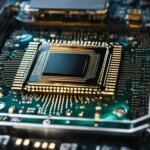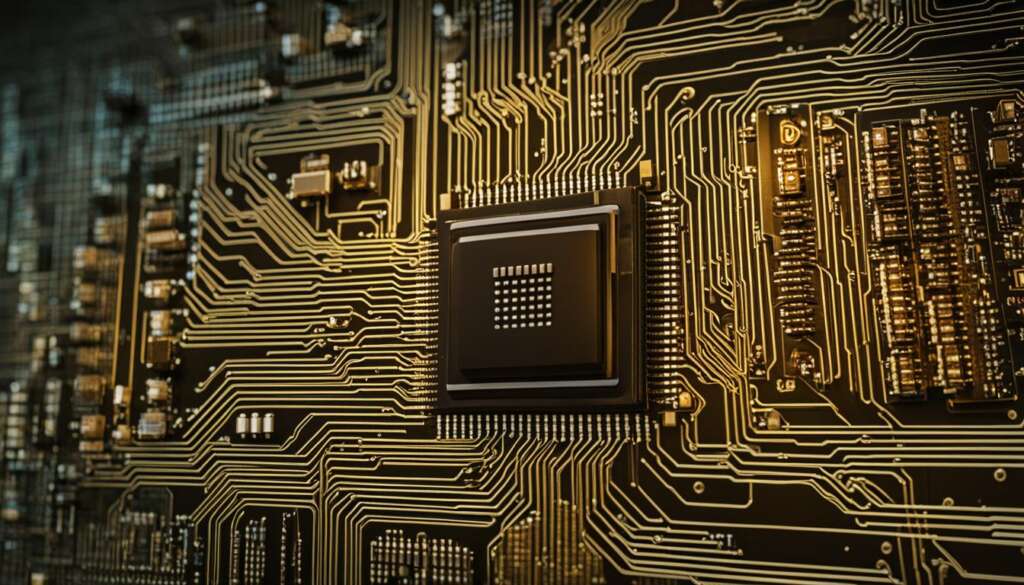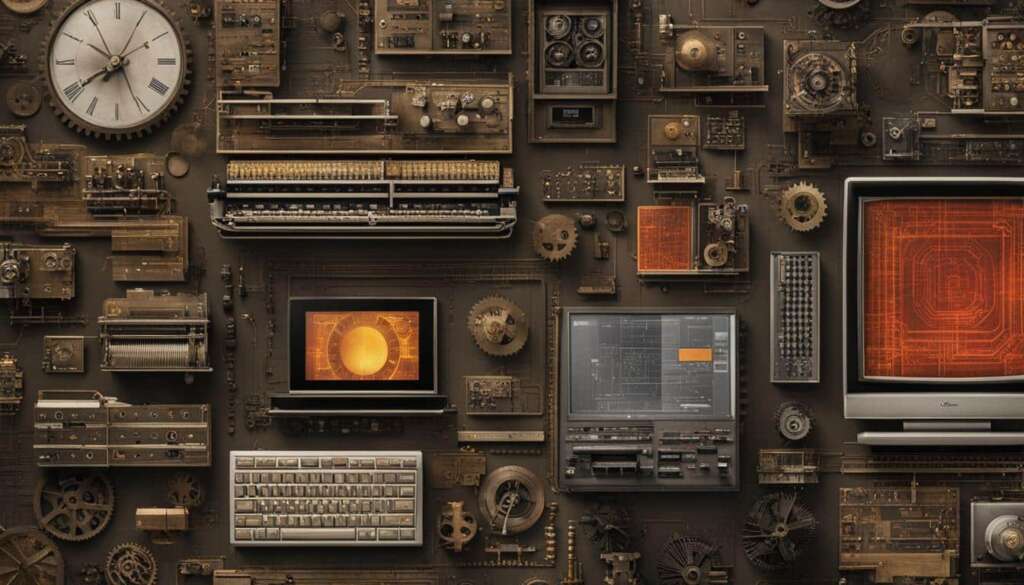Table of Contents
In the last century, computing technology has undergone a remarkable revolution. It began with large computers using vacuum tubes and has evolved into today’s powerful microchips made of silicon. These advancements have shaped the modern world and paved the way for the digital revolution.
If we delve into the history of computing, we can trace the path of technological advancements that have propelled us forward. From the humble beginnings of vacuum tubes to the intricate silicon chips that power our devices today, each step has brought us closer to a faster, more efficient computing experience.
The journey of computing evolution is not just a tale of hardware upgrades; it is a testament to human ingenuity and the relentless pursuit of progress. Join us as we explore the milestones and breakthroughs that have shaped the world of computing as we know it.
The Advent of Vacuum Tubes in Early Computers
The early days of computing were marked by the advent of vacuum tubes, which served as the cornerstone of the first generation computers. These large electronic devices, also known as electronic switches, played a crucial role in controlling the flow of electricity within computer circuits.
Vacuum tubes, though groundbreaking at the time, had their limitations. They were bulky, consumed large amounts of energy, and were prone to failure. However, their invention paved the way for the development of computationally powerful machines that laid the foundation for modern technology.
The vacuum tube era was an essential stepping stone in the evolution of computing. These electronic switches enabled the manipulation of data and paved the way for future breakthroughs in electronics.” – Dr. Catherine Johnson, Computing Historian
The use of vacuum tubes in early computers allowed for the execution of complex calculations and data processing. However, their size and energy requirements necessitated the development of smaller, more efficient alternatives to enable further progress in computing technology.
While vacuum tubes may no longer be in use today, their impact on the development of computers and the digital revolution cannot be overstated. Their invention and subsequent advancements led to the birth of modern computing, setting the stage for further breakthroughs in electronic components that continue to shape our world.
| Vacuum Tubes in Early Computers | Advantages | Limitations |
|---|---|---|
| 1. Electronically controlled switches | 1. Enabled complex calculations | 1. Bulky and large in size |
| 2. Foundation of first generation computers | 2. Facilitated data processing | 2. Consumed significant energy |
| 3. Precursor to modern electronic components | 3. Pioneered the field of computing | 3. Prone to frequent failures |
The Invention and Impact of Transistors
In the evolution of computer circuit board technology, the invention of transistors marked a significant milestone. Developed by Bell Labs in 1947, transistors revolutionized the world of electronics and had a profound impact on second-generation computers and circuit boards.
Unlike the large and energy-consuming vacuum tubes used in early computers, transistors were smaller, faster, and more reliable. They served as electronic switches that controlled the flow of electricity within computer circuits, making them essential components for building computers.
The introduction of transistors led to a remarkable leap in technological advancement. Printed circuit boards (PCBs) utilizing transistors replaced the bulky vacuum tube circuit boards, resulting in smaller and more powerful computers. This miniaturization allowed for increased computational capabilities and opened up new possibilities for the development of advanced software and applications.
The Impact of Transistors
“The invention of transistors paved the way for the development of smaller and more powerful computers, shaping the future of technology.”
With the introduction of transistors, the size and complexity of computer systems drastically reduced, making computers more accessible to a wider audience. The use of transistors also brought improvements in reliability, power efficiency, and speed, enabling the development of more sophisticated computer architectures.
Transistor-based circuit boards became the foundation for subsequent advancements in computing technology, leading to the rise of integrated circuits and the eventual development of microchips. These innovations would propel the evolution of computing power, leading to the creation of powerful laptops, smartphones, and other state-of-the-art computing devices we use today.
| Impact of Transistors on Computing | Benefits |
|---|---|
| Miniaturization of computers | Smaller and more portable devices |
| Increase in computational capabilities | Ability to perform complex tasks |
| Improved reliability and power efficiency | Longer battery life and reduced energy consumption |
| Advancements in computer architecture | Development of more powerful processors and systems |
The invention and impact of transistors have revolutionized the world of computing and paved the way for the technological progress we witness today. From the humble beginnings of vacuum tube computers to the emergence of microchips, the evolution of computer circuit board technology continues to shape our lives in ways unimaginable just a few decades ago.
The Rise of Integrated Circuits
The evolution of computer circuit boards took a major leap forward with the invention of integrated circuits, also known as microchips. Integrated circuits revolutionized computing in the late 1950s by condensing thousands, millions, or even billions of electronic components onto a single semiconductor material, typically silicon.
With the advent of integrated circuits, computers became smaller, more powerful, and more reliable. The compact size of microchips allowed for the development of more advanced and sophisticated electronic devices. The integration of multiple components onto a single chip also improved the efficiency and speed of data processing, leading to significant advancements in computing technology.
Integrated circuits became the foundation of modern computing systems and played a crucial role in driving technological progress. These small but powerful microchips have been responsible for the development of numerous electronic devices, from personal computers and smartphones to complex industrial machinery and space exploration equipment. The technological leap achieved by integrated circuits continues to shape our world today and holds great promise for the future of computing.
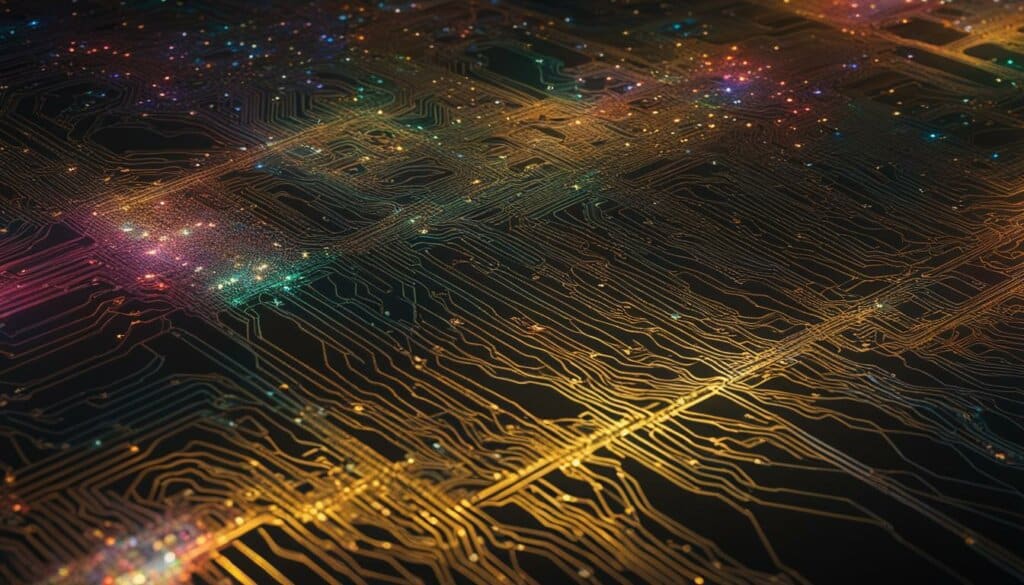
Advancements in Integrated Circuits
The development of integrated circuits has not been static since their inception. Technological advancements in the manufacturing process have allowed for the continual improvement of these microchips. The size of the components on integrated circuits has steadily shrunk, enabling even more dense circuit designs and increased computing power.
In recent years, advancements in transistor technology have played a crucial role in the evolution of integrated circuits. The introduction of new materials, such as graphene and carbon nanotubes, has the potential to further enhance the capabilities of microchips, making them even smaller, faster, and more efficient.
The relentless pursuit of smaller and more powerful integrated circuits has fueled innovation and driven the progress of the entire computer industry. As technology continues to evolve, we can expect further breakthroughs in integrated circuit design and manufacturing, ensuring that computing power continues to advance at an unprecedented pace.
| Advantages of Integrated Circuits | Disadvantages of Integrated Circuits |
|---|---|
|
|
Advancements in Computer Circuit Board Technology
Advances in computer circuit board technology have played a crucial role in the evolution of computing. One significant advancement is the miniaturization of electronic components. This has allowed for the development of smaller and more powerful devices, leading to sleeker and more efficient computers.
A notable technique that has emerged with miniaturization is surface mount technology (SMT). In SMT, components are directly mounted onto the circuit board, eliminating the need for bulky through-hole components. This results in more compact and lightweight devices, making them ideal for portable electronics such as smartphones and tablets.
The use of high-performance materials has also improved the durability and reliability of circuit boards. These materials, such as ceramics and composites, offer enhanced thermal conductivity and electrical insulation properties. They can withstand harsh environmental conditions, ensuring the longevity of electronic devices.
Another exciting development in circuit board technology is the emergence of flexible circuit boards. These boards are designed to bend and conform to various shapes, allowing for innovative applications in wearable devices and flexible displays. This flexibility opens up new possibilities for technology integration and design, enabling the creation of more versatile and user-friendly devices.
Let’s take a look at a table showcasing the key advancements in computer circuit board technology:
| Advancement | Description |
|---|---|
| Miniaturization | Reduction in size and weight of electronic components, leading to smaller and more powerful devices. |
| Surface Mount Technology (SMT) | Direct mounting of components onto the circuit board, eliminating the need for through-hole components. |
| High-Performance Materials | Use of materials like ceramics and composites for improved durability and reliability. |
| Flexible Circuit Boards | Boards designed to bend and conform to various shapes, enabling innovative applications in wearable devices and flexible displays. |
These advancements in computer circuit board technology have paved the way for the development of state-of-the-art computers and electronic devices. As technology continues to evolve, we can expect further breakthroughs in this field, leading to even more compact, powerful, and flexible devices that enhance our everyday lives.
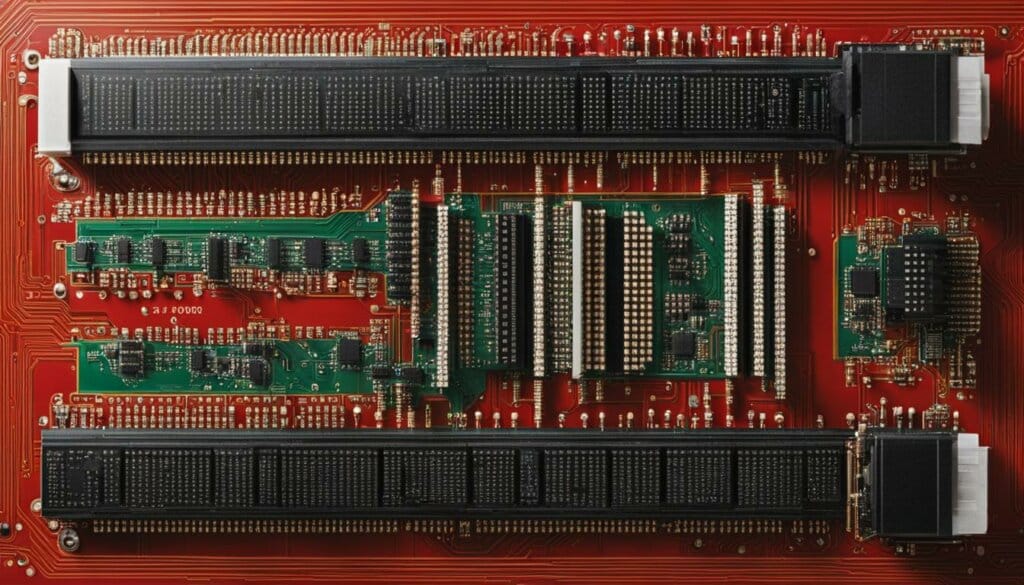
The Impact of Materials Science and Manufacturing Processes
Materials science and manufacturing processes have played a crucial role in shaping the evolution of computer circuit boards. Through advancements in high-performance materials and manufacturing techniques, circuit boards have become more durable, reliable, and capable of withstanding harsh environments. These advancements have significantly contributed to the overall progress of computing technology.
One key development in materials science is the use of high-performance materials such as ceramics and composites in circuit board manufacturing. These materials offer enhanced durability and resistance to temperature fluctuations, moisture, and other environmental factors. By incorporating these materials into circuit board designs, manufacturers can ensure that their products can operate reliably even in demanding conditions.
In addition to high-performance materials, advancements in manufacturing processes have also had a significant impact. These processes have become more efficient and cost-effective, allowing for the mass production of circuit boards with high precision and quality. Techniques such as surface mount technology (SMT) have revolutionized circuit board assembly, enabling components to be mounted directly onto the board, reducing size and improving performance.
| Advancements | Impact |
|---|---|
| Use of high-performance materials | Enhanced durability and reliability |
| Improved manufacturing processes | Efficient and cost-effective production |
| Surface mount technology (SMT) | Smaller and more efficient circuit boards |
With the continuous advancement of materials science and manufacturing processes, circuit boards have become more robust and capable of meeting the demands of modern computing. These enhancements have allowed for the development of smaller, more powerful devices that can effectively process vast amounts of data. The integration of high-performance materials and innovative manufacturing techniques ensures that the evolution of computer circuit boards will continue to drive the progress of computing technology.
The Role of Programming Languages and Operating Systems
Programming languages and operating systems are fundamental components of modern computing. They play a crucial role in software development and enable computers to perform complex tasks. Programming languages provide developers with the tools to write code and create applications, while operating systems manage computer resources and provide a platform for software execution.
Over the years, numerous programming languages have been developed to meet different needs and suit various applications. Fortran and COBOL, developed in the 1950s and 1960s, were among the earliest high-level programming languages. They allowed programmers to write code in a more human-readable format, making it easier to develop and maintain software.
Fortran and COBOL revolutionized the field of scientific and business computing, respectively. They paved the way for future programming languages and laid the foundation for the software development industry.
Operating systems, on the other hand, provide the necessary infrastructure for running software and managing computer resources. They handle tasks such as memory management, process scheduling, and device drivers. Operating systems like MS-DOS and UNIX have played pivotal roles in the evolution of computing by providing a standardized environment for software development and facilitating computer operation.
As technology continues to advance, programming languages and operating systems evolve alongside hardware advancements. New programming languages are developed to address emerging needs, such as Python for data analysis and JavaScript for web development. Operating systems constantly improve to enhance performance, security, and user experience. The ongoing development of programming languages and operating systems ensures that software can utilize the full potential of hardware advancements and drive the progress of computing.
The table below outlines some popular programming languages and operating systems:
| Programming Languages | Operating Systems |
|---|---|
| Python | Windows |
| Java | MacOS |
| C++ | Linux |
| JavaScript | Android |
| Swift | iOS |
These programming languages and operating systems represent just a fraction of the vast ecosystem of technologies that enable software development and computer operation. They continue to evolve and shape the computing landscape, fueling innovation and driving the progress of modern technology.
The Era of Personal Computing
The 1980s witnessed a significant milestone in the evolution of computing with the advent of personal computers. Prior to this era, computers were primarily used by businesses and institutions due to their high cost and complexity. However, advancements in technology and the introduction of user-friendly systems made computers more accessible to the general public.
One of the most notable developments during this time was the introduction of graphical user interfaces (GUIs). Instead of relying solely on command-line interfaces, GUIs allowed users to interact with computers through visual icons, menus, and windows. This breakthrough in user interface design made computers more intuitive and easier to use, ultimately contributing to their widespread adoption.
With the rise of personal computing, individuals gained the ability to harness the power of computers for various tasks, from word processing and spreadsheet management to graphic design and gaming.
Personal computers also became more affordable, thanks to advancements in hardware and manufacturing. This accessibility enabled more people to own their own computers and explore the vast possibilities that computing offered.
| Advantages of Personal Computers | Disadvantages of Personal Computers |
|---|---|
| Increased productivity | Hardware limitations compared to mainframe computers |
| Expanded creativity and innovation | Less secure than mainframe computers |
| Enhanced communication and connectivity | Limited memory and storage capacity |
| Opportunity for self-learning and personal development | Potential for software compatibility issues |
The era of personal computing laid the foundation for the modern digital age. Today, personal computers are an integral part of our daily lives, empowering us to connect, create, and explore in ways never before possible.
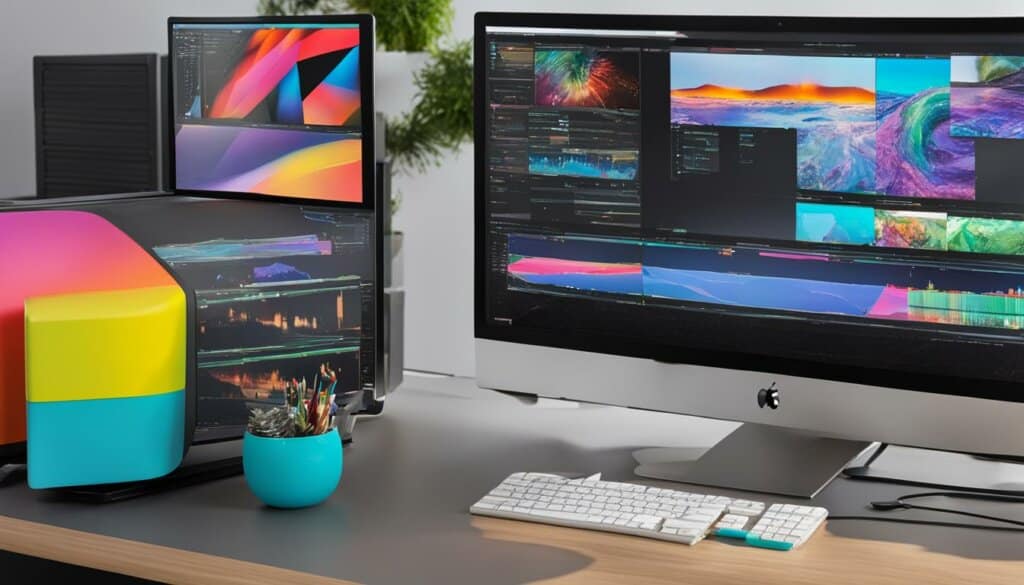
Unix, Linux, and the Diversity of Operating Systems
In the ever-evolving world of computing, the realm of operating systems has seen its fair share of transformations and innovations. One of the most influential branches of operating systems can be traced back to the development of Unix in the 1970s. Initially created as a platform for academic and business use, Unix quickly gained popularity and became the foundation for various versions maintained by different entities.
However, it was in the early 1990s that a significant breakthrough occurred with the creation of Linux by Linus Torvalds. Linux, a free Unix-like operating system, revolutionized the computing landscape by offering a robust, customizable, and community-driven alternative. Its open-source nature and compatibility with existing Unix systems made Linux a popular choice for both individuals and organizations.
Today, Linux has become a powerhouse in the world of operating systems. It is widely used in datacenters across the globe, powering critical infrastructure and driving technological innovation. Furthermore, Unix-based operating systems, including Linux, are the driving force behind billions of personal computing devices, from smartphones to laptops. This diversity of operating systems has contributed to a rich ecosystem where different platforms cater to varying needs and preferences.
Table: A Comparison of Unix and Linux
| Unix | Linux | |
|---|---|---|
| Origin | Developed in the 1970s as a proprietary operating system, with various versions maintained by different entities | Created in the early 1990s by Linus Torvalds as a free and open-source alternative to Unix |
| Source Code | Proprietary, with limited access to the source code | Open-source, allowing community collaboration and customization |
| Licensing | Varies depending on the version; commercial licenses available for some versions | Released under the GNU General Public License, granting users the freedom to modify and distribute the software |
| Community | Varied communities and organizations maintain different versions | A vibrant global community of developers and enthusiasts contribute to its development and support |
| Popular Distributions | BSD, Solaris, AIX | Ubuntu, Fedora, Debian, CentOS |
| Market Share | Primarily used in enterprise environments and academia | Extensively used in servers, smartphones, embedded systems, and cloud computing |
The legacy of Unix and the rise of Linux have shaped the landscape of operating systems, providing users with a diverse range of choice and functionality. Whether it’s the robustness and reliability of Unix or the customization and community-driven development of Linux, these operating systems continue to play a vital role in shaping the world of computing.
The Influence of Integrated Circuits and Miniaturization
The continuous advancements in integrated circuits and the relentless drive towards miniaturization have revolutionized the world of computing. The ongoing quest for smaller and more powerful components has led to the development of increasingly dense circuit designs, resulting in improved performance and enhanced functionality.
Integrated circuits, also known as microchips, have played a pivotal role in this transformation. These tiny chips pack thousands, millions, or even billions of electronic components onto a single semiconductor material, such as silicon. The ability to integrate such a large number of components into a compact size has not only made computers smaller and more portable but has also significantly improved their processing speed and efficiency.
Transistor advancements have been a driving force behind the miniaturization of integrated circuits. Transistors, which act as electronic switches, control the flow of electricity within computer circuits. With each generation, transistors have become smaller and more efficient, allowing for more complex and powerful circuit designs. The introduction of graphene and carbon nanotubes shows promising potential for even smaller and faster transistors in the future.
| Advancements | Influence |
|---|---|
| Integrated Circuits | Smaller and more powerful computers |
| Miniaturization | Dense circuit designs |
| Transistor Advancements | Improved performance |
The relentless pursuit of smaller and more powerful components, driven by integrated circuits and transistor advancements, has not only shaped the current landscape of computing but also holds the key to the future. As technology continues to advance, the possibilities for further miniaturization and performance improvements are limitless. The influence of integrated circuits and miniaturization on computing power is undeniable, and their impact will continue to propel the evolution of technology.
The Modern Smartphone and Laptop
Modern smartphones and laptops represent the pinnacle of hardware innovation and software evolution in the field of computing. These state-of-the-art computers have revolutionized the way we work, communicate, and access information.
Today’s smartphones are powerful handheld devices that combine the functionality of a phone, camera, music player, and computer into one compact device. They feature high-resolution displays, advanced processors, and ample storage capacity to run complex applications and store vast amounts of data. With internet connectivity, GPS, and various sensors, smartphones have become indispensable tools that keep us connected and informed wherever we go.
Laptops, on the other hand, provide a portable computing solution with more power and versatility than a smartphone. They offer larger screens, full-sized keyboards, and a range of connectivity options. Laptops are designed for productivity, allowing users to run resource-intensive applications, multitask, and create content on the go.
Both smartphones and laptops rely on sophisticated operating systems, such as Android, iOS, Windows, and macOS, which have evolved over the years to provide intuitive interfaces and seamless user experiences. These operating systems support a wide range of applications and services, enabling users to customize their devices and adapt them to their specific needs.
In conclusion, the modern smartphone and laptop embody the culmination of hardware innovation and software evolution. They have transformed the way we live and work, providing us with powerful tools that fit in the palm of our hands or in our backpacks. As technology continues to advance, we can expect even more groundbreaking developments in the world of computing.
Conclusion
The evolution of computing power has been a remarkable journey, from the early days of vacuum tubes to the advanced silicon chips of today. Technological progress in both hardware and software has shaped the modern world and continues to push the boundaries of computing.
Throughout the years, we have witnessed the development of increasingly smaller and more powerful components. From the advent of vacuum tubes and the invention of transistors to the rise of integrated circuits and the miniaturization of electronic components, each innovation has propelled computing forward. These advancements have allowed for denser circuit designs, improved performance, and more efficient computing systems.
Furthermore, the role of programming languages and operating systems cannot be understated. The development of programming languages like Fortran and COBOL, as well as operating systems like MS-DOS and UNIX, have paved the way for software development and computer operation as we know it today. The legacy of Unix and the rise of Linux have contributed to the diversity of operating systems, powering billions of personal computing devices worldwide.
As we look to the future, the quest for smaller, more powerful components continues. Advancements in transistor technology, such as graphene and carbon nanotubes, hold the promise of even faster and smaller transistors. The ongoing evolution of computing promises to bring us state-of-the-art devices and drive technological progress across various industries. So, let us embrace this never-ending journey of computing evolution, where innovation knows no bounds.
FAQ
What were vacuum tubes used for in early computers?
Vacuum tubes were used as switches to control the flow of electricity in computer circuits.
How did transistors impact computer circuit board technology?
Transistors were smaller, faster, and more reliable than vacuum tubes, leading to the development of smaller and more powerful computers.
What are integrated circuits and how did they revolutionize computing?
Integrated circuits, or microchips, contain thousands, millions, or even billions of electronic components on a single semiconductor material, such as silicon. They became the foundation of modern computing.
What advancements have been made in computer circuit boards?
Advancements include the miniaturization of electronic components, the development of surface mount technology (SMT), and the emergence of flexible circuit boards.
How have materials science and manufacturing processes influenced circuit boards?
The use of high-performance materials like ceramics and composites has resulted in more durable and reliable circuit boards. Advances in manufacturing have also made production more efficient and cost-effective.
What role do programming languages and operating systems play in computing?
Programming languages allow developers to write instructions for computers, while operating systems facilitate computer operation and software development.
What marked the era of personal computing?
The era of personal computing began in the 1980s when computers became more affordable and accessible to the general public.
What is the legacy of Unix and the rise of Linux?
Unix became a widely used operating system, eventually splitting into different versions. Linux, a free Unix-like operating system, gained widespread adoption and is used in data centers worldwide.
How have integrated circuits and miniaturization impacted computing power?
Smaller and more powerful chips have allowed for denser circuit designs and improved performance. Advancements in transistor technology hold the potential for even smaller and faster transistors in the future.
How have smartphones and laptops evolved?
Modern smartphones and laptops are the culmination of decades of hardware innovation and software evolution, incorporating foundational technologies and operating systems derived from Unix.
{
“@context”: “https://schema.org”,
“@type”: “FAQPage”,
“mainEntity”: [
{
“@type”: “Question”,
“name”: “What were vacuum tubes used for in early computers?”,
“acceptedAnswer”: {
“@type”: “Answer”,
“text”: “Vacuum tubes were used as switches to control the flow of electricity in computer circuits.”
}
},
{
“@type”: “Question”,
“name”: “How did transistors impact computer circuit board technology?”,
“acceptedAnswer”: {
“@type”: “Answer”,
“text”: “Transistors were smaller, faster, and more reliable than vacuum tubes, leading to the development of smaller and more powerful computers.”
}
},
{
“@type”: “Question”,
“name”: “What are integrated circuits and how did they revolutionize computing?”,
“acceptedAnswer”: {
“@type”: “Answer”,
“text”: “Integrated circuits, or microchips, contain thousands, millions, or even billions of electronic components on a single semiconductor material, such as silicon. They became the foundation of modern computing.”
}
},
{
“@type”: “Question”,
“name”: “What advancements have been made in computer circuit boards?”,
“acceptedAnswer”: {
“@type”: “Answer”,
“text”: “Advancements include the miniaturization of electronic components, the development of surface mount technology (SMT), and the emergence of flexible circuit boards.”
}
},
{
“@type”: “Question”,
“name”: “How have materials science and manufacturing processes influenced circuit boards?”,
“acceptedAnswer”: {
“@type”: “Answer”,
“text”: “The use of high-performance materials like ceramics and composites has resulted in more durable and reliable circuit boards. Advances in manufacturing have also made production more efficient and cost-effective.”
}
},
{
“@type”: “Question”,
“name”: “What role do programming languages and operating systems play in computing?”,
“acceptedAnswer”: {
“@type”: “Answer”,
“text”: “Programming languages allow developers to write instructions for computers, while operating systems facilitate computer operation and software development.”
}
},
{
“@type”: “Question”,
“name”: “What marked the era of personal computing?”,
“acceptedAnswer”: {
“@type”: “Answer”,
“text”: “The era of personal computing began in the 1980s when computers became more affordable and accessible to the general public.”
}
},
{
“@type”: “Question”,
“name”: “What is the legacy of Unix and the rise of Linux?”,
“acceptedAnswer”: {
“@type”: “Answer”,
“text”: “Unix became a widely used operating system, eventually splitting into different versions. Linux, a free Unix-like operating system, gained widespread adoption and is used in data centers worldwide.”
}
},
{
“@type”: “Question”,
“name”: “How have integrated circuits and miniaturization impacted computing power?”,
“acceptedAnswer”: {
“@type”: “Answer”,
“text”: “Smaller and more powerful chips have allowed for denser circuit designs and improved performance. Advancements in transistor technology hold the potential for even smaller and faster transistors in the future.”
}
},
{
“@type”: “Question”,
“name”: “How have smartphones and laptops evolved?”,
“acceptedAnswer”: {
“@type”: “Answer”,
“text”: “Modern smartphones and laptops are the culmination of decades of hardware innovation and software evolution, incorporating foundational technologies and operating systems derived from Unix.”
}
}
]
}





